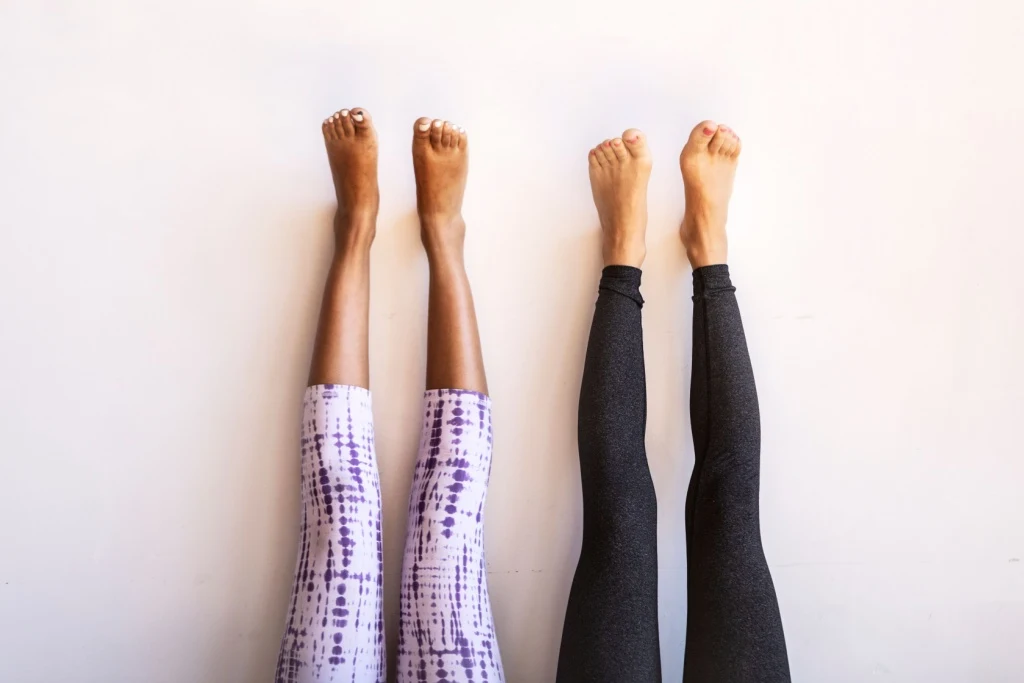Why The Legs Up The Wall Pose Has So Many Benefits
Here’s why you should give it a go.

February 11, 2025 - Updated February 11, 2025

Whether yoga is a regular part of your routine or you don’t know your yin from your vinyasa, you may have come across the popular legs up the wall pose before. While many go-to yoga poses require a fair bit of strength, flexibility and coordination, this beginner-friendly movement can be mastered by almost anyone.
What is the legs up the wall pose?
Known as Viparita Karani in Sanskrit, this restorative pose requires you to do exactly what it says on the box, placing your legs up the wall as you lie flat on the ground.
After placing your yoga mat on the ground, begin in a seated position with your right side up against a wall and your legs extended along the base. Then, rotate your torso down towards the mat and sweep your left leg up the wall, followed by your right. You should now be lying on your back with both legs extended up the wall and in line with your hips with your arms resting in a comfortable position on either side of your body.
You should aim to hold this position for three to five minutes, continuously breathing in and out through your nose. If you need extra support, place a pillow or towel under your hips.

What are the benefits of this pose?
Along with poses like the reclining pigeon and child’s pose, legs up the wall is one of our go-to restorative yoga poses to enjoy if you’re trying to de-stress at the end of a long day, with Cleveland Clinic highlighting that many find this position to be incredibly calming. But the benefits don’t stop there.
Better sleep
When it comes to improving the quality of your shut-eye, yoga is a popular training style to turn to, with a US survey finding that over 55% of yogis say the practice helped them to get better sleep. If sleep is the aim of the game, Harvard Health suggests a calming flow that incorporates poses such as legs up the wall.
Depending on what stage of your menstrual cycle you’re currently at, you might find the impact of yoga and poses like this one even more effective than usual, with one study finding a practice including the legs up the wall pose reduced sleep disturbances in people suffering from PMS.
Improved circulation
This is a great pose to help with any stiffness, soreness or swelling that might come from sitting or standing all day, and Michigan Medicine and Cleveland Clinic both highlight that one of the most popular benefits of elevating your legs above your head is improving circulation and blood flow to your entire body.
Less bloating and better digestion
Anecdotal evidence also suggests that this pose can help alleviate bloating and aid digestion, so add this to your list of at-home remedies to try next time you’ve had a big meal.
Should anyone avoid the legs up the wall?
While almost anyone can master this move, regardless of skill level, Cleveland Clinic does caution that some health conditions make this pose one to avoid.
If you have glaucoma (fluid pressure within the eyes), conditions that cause excessive fluid retention such as congestive heart failure, kidney failure, liver failure or cirrhosis or uncontrolled high blood pressure, healthcare professionals recommend you steer clear of this pose.
Yoga in the Sweat app
If you’ve given this relaxing pose a go and want to include more yoga in your routine, there’s plenty of options in the Sweat app. With three yoga programs to choose from, Body and Mind, Yoga with Ania and Yoga with Phyllicia, as well as individual sessions available On Demand, we’ll see you on the mat.

Amy is a writer and editor at Sweat. She has over a decade of experience in women’s publishing and digital media and has previously worked across titles including Mamamia, Grazia and Cosmopolitan.
* Disclaimer: This blog post is not intended to replace the advice of a medical professional. The above information should not be used to diagnose, treat, or prevent any disease or medical condition. Please consult your doctor before making any changes to your diet, sleep methods, daily activity, or fitness routine. Sweat assumes no responsibility for any personal injury or damage sustained by any recommendations, opinions, or advice given in this article.
Wellbeing